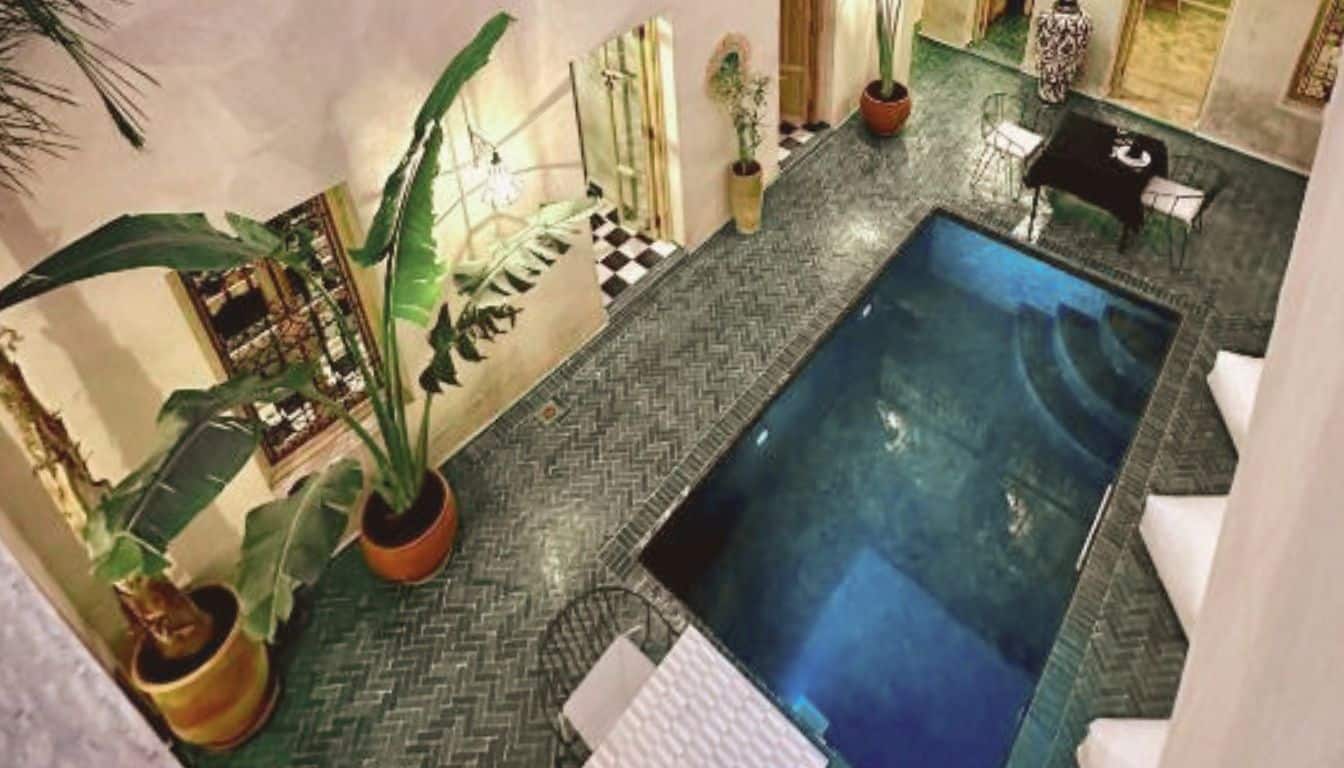Have you ever wondered what makes riads so special? These houses in Morocco offer a true immersion into the local culture. With their interior gardens and unique designs, they captivate. However, living in a riad isn’t always easy.
These riads offer a haven of peace away from the hustle and bustle of the city. Inspired by the Moroccan wast ed-dar , they ensure incomparable tranquility . Jean Gallotti speaks so well of them. But maintaining such a place requires a lot of effort. So, how do they compare to other accommodations? Let’s take a look at the pros and cons of riads.
Key points
- A Riad is a Moroccan house with an enclosed interior garden .
- Riads offer a unique cultural and architectural experience.
- Despite their charm, the maintenance and management of riads can be restrictive.
- Riads are usually located in medinas, offering privacy and tranquility .
- Modern towers and hotels may offer more facilities, but lack the intimacy of a riad .
Definition and origin of the Riad
Riads, a unique Moroccan home, are renowned for their timeless charm. According to a precise definition, they are dwellings centered around a patio . This patio usually has an interior garden .
The history of the term “Riad”
The origin of the riad comes from the Arabic word “rawd,” which means small and perfect garden. This architecture aims for seclusion and inner peace. It is recognized by features such as inward openings and Zellij decorations.
Difference between Riad and Dar
The riad goes beyond the simple idea of a house. Unlike the dar, which does not have a garden, the riad includes a green space at its heart. This interior courtyard highlights the historical and cultural value of Moroccan architecture.
The characteristics of a Moroccan Riad
The Moroccan riad is an architectural gem located in the medinas of cities such as Marrakech and Fez. It is characterized by a central interior patio surrounded by columns and galleries. The bedrooms are often upstairs, offering access to a terrace with views of the city.
Structure and design
The riad’s structure emphasizes intimacy with its high walls. Its design blends the beauty of Islamic architecture with local craftsmanship. At its heart is a patio, enriched with a fountain and plants.
The architecture creates a unique play of light.
Importance of the garden and the patio
The riad’s interior garden is a peaceful space, essential for a serene atmosphere. Orange trees are often found here, adding a delicious fragrance. The modern swimming pools do not detract from the authentic charm of these places.
Tourist attraction
Since the 1990s, riads have been attracting many visitors to Morocco. They offer a perfect balance between tradition and modernity. These establishments, whether hotels, guesthouses, or restaurants, guarantee a unique experience at the heart of Moroccan culture.
The advantages of staying in a Riad
Staying in a riad in Morocco is a unique adventure. It combines comfort with authenticity. Located in the medinas, these traditional accommodations charm those looking to live like the locals.
The advantages are numerous: calm, privacy and discovery of the local culture.
Peace and privacy
Tranquility and privacy are key features of riads. Their centralized design creates a peaceful atmosphere. It’s unlike any ordinary hotel.
These places offer a peaceful retreat from the busy streets. The interior decor, with its gardens and fountains, adds to the sense of serenity.
Unique cultural experience
A stay in a riad offers more than just a roof over your head. It’s an immersion into Moroccan culture. Each riad embodies this art of living through its architecture and cuisine.
It features local secrets, typical dishes, and cultural activities. These experiences enrich the visitor with the true essence of Moroccan culture.
The best cities to find Riads
Morocco’s cities are rich in riads, each unique. Marrakech, Fez, and Meknes stand out. They offer traditional Moroccan accommodation , ideal for an authentic experience.
Marrakesh
In Marrakech, you’ll find many riads to suit all budgets. Riads in Marrakech are known for their traditional houses near the medina. Some riads offer luxury and comfort, with swimming pools, spas, and beautiful views.
Fez
Riads in Fez immerse you in Moroccan culture with their unique architecture. They feature arches, decorated ceilings, and zelliges. The city is full of renovated riads, perfect for a cultural immersion .
In Fez, the madrasas and narrow streets invite exploration. It’s an ideal place to admire local architecture and experience Moroccan life.
Meknes
Meknes is less touristy, but its riads are worth the detour. Riads in Meknes vary, ranging from intimate homes to larger properties. These accommodations sometimes offer special activities, such as cooking classes or guided tours.
Conclusion
Moroccan riads are much more than just places to stay. They are an important part of Morocco’s history and lifestyle. These ancient houses offer a true taste of cultural tourism. They are known for their unique architectural style and beautiful interior gardens.
Places like Riad Enchanté in Marrakech are treasures. They serve delicious breakfasts and offer a warm welcome. You’ll feel the true pulse of the local culture.
Compared to hotels, riads offer a more intimate and personalized environment. Located in the heart of the medinas, they immerse you in true Moroccan culture. Their unique architectural details, such as intricate tiles and central patios, capture the essence of Moroccan architecture.
In the city of Marrakech, you’ll find a wide range of riads, from luxurious to more budget-friendly. This demonstrates the great variety in Moroccan accommodation. Riads offer everyone an enriching experience, drawing on a rich history and unique charm.
